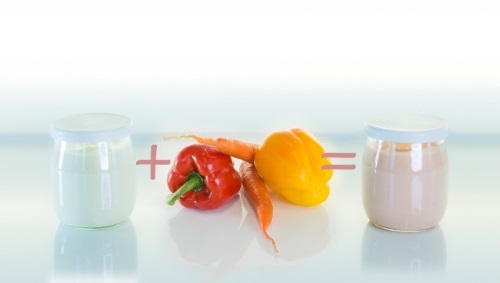Color is important to consumers when they buy food and beverages.
The reason for this is simple – we eat with our eyes.
An attractive color indicates the taste and quality, while simultaneously evoking feelings and emotions, thereby making food more appealing.
As consumers increasingly search for indulgence and exciting new creations, color has become one of the most important features – or even the most important one – to help products to stand out on supermarket shelves.
Market research institute Innova Market Insights even identified “Say it with color” as one of the top 10 trends for food and beverages in 2018.
In addition, Innova said 10% of consumers from Australia, Mexico, Spain and the US are influenced by social media when purchasing food and beverages.
This is already the case for 20% of Chinese and Indian consumers.
2018 is the year for purple
While product launches are more colorful, innovative and vibrant than ever before, purple stands out in 2018.
In its multitude of shades and intensities, it is one of the hottest food trends of 2018.
Hues such as violet, soft lavender, grape blue and lilac are attracting the consumer’s eye.
Purple can be used to upgrade a multitude of applications: purple-colored blueberry porridge for breakfast lovers; violet croutons on soups or salads for lunch; berry-flavored granola bars as snacks and lavender lemonade.
The power of purple
The trend towards purple foods and beverages is rooted in health and wellness, as well as visual appeal.
While recent color innovations such as ‘unicorn’ or ‘rainbow’ evoked feelings of fun and intrigue, purple indicates a high phytonutrient content for fruits and vegetables which signals well-being to consumers.
As a result, vegetables such as purple carrots, sweet potatoes and yams are also appearing more frequently in supermarkets.
The relevance of health associations has not come about by chance.
For several years now, consumers have put a growing emphasis on naturalness, causing the food and beverage market to change permanently.
Due to the global health drive, people are better informed about nutrition and the possible effects that certain ingredients might have on their well-being.
They increasingly care about what they consume, because when treating themselves they want to do it without a bad conscience or concerns for their health.
They are much more skeptical towards additives and ingredients, especially those with unfamiliar names.
Additives are met with opposition
As a result of the growing pressure from consumers, more and more governments and regulatory authorities are also putting additives under scrutiny, while paving the way for the use of natural alternatives.
Stricter regulations regarding the labeling of synthetic colorants are one example.
In Saudi Arabia, for instance, products that contain one of four colorants (including Tartrazine and Allura Red AC) have to carry the on-pack warning statement, “This material may have an adverse effect on activity and attention in children”.
The European Guidance Notes and China Group Standard on the classification of food extracts with coloring properties have given manufacturers more clarity about a truly natural alternative: Coloring Foods.
Coloring Foods will make a perfect clean-label solution.
They are based on the simple concept of coloring food with other food.
They are obtained exclusively from fruit, vegetables and edible plants and are processed using only gentle physical methods, rather than chemicals.
The concentrates can therefore be categorized as ingredients and simply labeled as such, for example as ‘Coloring Food (concentrate of cherry, carrot)’ or ‘concentrates (cherry, carrot)’.
Full vertical integration
When using colors from fruit and vegetables, EXBERRY can for example offer performance in terms of variety, stability, shelf life and color brilliance.
To ensure all of this, there is full vertical integration of the supply chain.
For the production of the color concentrates, every step from field to fork is monitored closely.
By growing raw materials that are optimized for color content, a very high yield of color is achieved.
The product range is cultivated by working with farmers who only grow those varieties that have been proven through many years of experience and agricultural knowledge.
Harvesting is done at peak ripeness – when the color of the relevant fruit, vegetables and plants has developed to its optimum level.
The entire process is controlled and monitored on site by agronomists.
Fresh materials are processed within hours of harvest to prevent color deterioration.
The production process can be compared to common methods used in a domestic kitchen.
Raw materials are chopped, pressed, boiled and filtered.
To ensure year-round availability, irrespective of the season, and to offer the crop yield at stable prices, a two-step production process has been implemented.
In the first step, raw materials are turned into semi-finished concentrates that are always in stock.
These stock ingredients are then blended into the final concentrates whenever ordered by a customer.
To create every desired shade, a proprietary blending procedure has been developed for EXBERRY.
Instead of offering only single-source solutions, up to three different raw materials are mixed to achieve the perfect hue for every application.
For instance, to create purples, raw materials such as black carrot, beetroot, purple sweet potato or spirulina are used.
Reduced caking for Coloring Foods powders
In previous years, Coloring Foods have been most commonly produced as liquids to serve the need of many products.
However, there is a growing demand for ingredients in powder form.
There are various reasons for this, of which handling and performance are the most important.
Powders are, for instance, in favor when a continuous cooling chain cannot be assured.
As opposed to liquid concentrates, fruit and vegetable powders can suffer from caking, a typical defect that has limited their use.
Caking of food powders typically occurs under exposure to sub-optimal storage conditions such as high humidity and temperatures.
Coloring Foods are sensitive to this as they contain high proportions of low-molecular sugars and organic acids.
They are more prone to develop physical and chemical changes when exposed to such harsh conditions.
The reduction of caking is particularly important because when powder particles stick to each other and start to cake, this affects the flowability of ingredients in powder form and the ability to achieve a homogeneous color impression in dry applications.
How caking occurs
Under conditions of elevated moisture and/or high temperatures, the viscosity of powders decreases and molecular mobility is increased.
This effect promotes the formation of inter-particle liquid bridges and eventually causes stickiness – which develops in the rubbery state at a specific temperature.
Above a critical moisture content, this temperature and thus the sticky point may drop below the ambient temperature, enabling caking to occur.
By investigating these causal relations, the EXBERRY specialists have been able to develop fruit and vegetable concentrates with improved material constants that reduce the tendency towards caking.
The optimized powders perform well even under harsh conditions of elevated relative humidity and/or temperatures.
The concentrates can be applied to applications such as beverages, confectionery, bakery, dairy products, snacks and savory applications like soups, sauces or meat.
The range is also compatible with low pH values, and is suitable for vegetarian, vegan and halal diets.
Story by Victor Foo, General Manager, GNT Singapore












